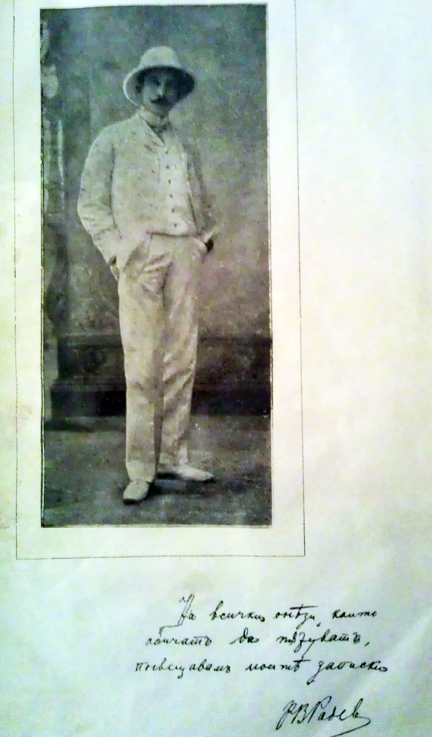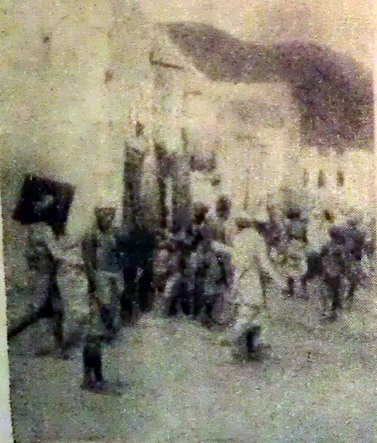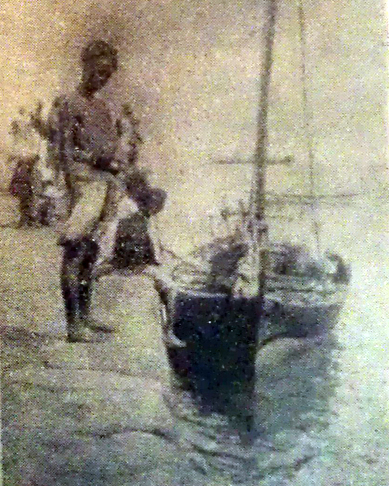
Photo of R. V. Radev with signature: “For these who love to travel, i devote my travel notes.”
The blogger Ruslan Trad has sent along an interesting piece regarding a Bulgarian traveler to Yemen, R. V. Radev, who published a book on his travels in 1906. If you can read Bulgarian, check out the original blog item. Otherwise, Ruslan has sent me a brief translated excerpt and some of the photographs, which I include here.
“Much like the Bedouin in the vast desert – one of those few unknown patches on the Earth’s surface, unexplored by Europeans – the Arab of the Happy Arabian coast today fights a legendary battle that turns fighters into heroes, invulnerable even to the slashes of the vengeful, merciless blade of Istanbul. A revolutionary network with its center in Syria is redoubling its efforts and preparing to sweep over all of Arabia, which has an estimated population of 12 million. Standing in the path of these millions is nothing more than one or two hundred thousand government clerks, looters, Turks and a few garrisons, spread around fortified checkpoints – a battle that would take no more than a couple of days to reach a favorable outcome, were it not for the proverbial scuffles between the various chiefs of the numerous tribes inhabiting Arabia, or for Turkey’s underhanded tactics in handing out bribes – gifts to some, privileges and unlimited power to others. Turkey sows the seeds of rivalry among the Sheikhs so they would fight and destroy each other. Neither the masses, nor the intellectual class, the rich Arabs, seem to understand that it would take no more than a couple of hours to resolve the issue of freedom and independence for Arabia, for which so much blood has, and continues to be shed…”
“Today, the battle is limited to Yemen, a strip along the Red Sea – a wealthy country called Happy Arabia (Arabia Felix). The rebel leader – Mahmoud Yahya is truly happier than his predecessors, for he boasts an army of several thousand fighters. For lack of strict organization and ammunition, he never enters an open battle. Instead, he prefers hit-and-run tactics – the scourge of any standing army, forced to be constantly vigilant, constantly haunted and attacked by small cavalry squads on horseback and camels, bringing fire to the Turkish camp like a hurricane, wreaking havoc, taking victims, giving some of their own in return, before vanishing into thin air like ghosts into the desert – that vast graveyard from which armies never return. Feizi Pasha is now sentenced to waste away and wait for his own imminent downfall; his forces deserting him, dying out from the heat or illness; starvation is their reality, looting – their livelihood, demoralization – their present, and the grave – their inevitable prospect.”
Â
The revolt in question appears to be that instigated by the election of Muhammad ibn Yahya Hamid al-Din as Imam al-Mansur in 1892. This resulted in a general rebellion against Ottoman control and some 70,000 tribesmen are reported to have surrounded Sanaa. In 1892 Ahmed Feizi Pasha arrived in Hodeida as the governor and marched up through Manakha to Sanaa, destroying three hundred villages along the way. He attempted to negotiate with the new imam, who refused to accept the Ottoman civil code. This resulted in a virtual standoff with many Yemeni scholars imprisoned and dismal living conditions all around. The siege of Sanaa is described in detail by Caesar Farah (The Sultan’s Yemen: Nineteenth-Century Challenges to Ottoman Rule, London: I.B. Tauris, 2002, pp. 166-173), Farah writes:
“The sustained siege cast fear in the hearts of the inhabitants and led to food shortages and higher prices. the besiegers used long ladders made of hardened walnut wood to climb the walls when the conditions of the besieged had severely deteriorated through lack of food, adequate clothing, illness and disease, for they dwelt in unhealthy residences, while those greedy to overwhelm and plunder the city intensified their efforts to seize it. The inhabitants suffered no less than the Turks, for they prayed day and night to God for deliverance. They were forced to sell their possessions to obtain scarce food. The rebels fell upon anybody who ventured out to escape the intolerable conditions, robbing them and violating their women. This disobeyed Imam al-Mansur’s orders that they secure the roads, give aid to the poor and weak, and rescue those suffering unusual weakness and hardship.”
Ruslan Trad discovered an account of the early part of the rebellion in an obscure Australian newspaper, which is reproduced below.
ARAB REVOLT IN YEMEN
The insurrection by the Arabs in the district of Yemen, south-west of Arabia, against the Turkish rule, is extending. The insurgents attacked a body of Turkish troops who were sent against them, killing several officers and 100 men. They afterwards cut the telegraph wires.
The latest reports from the scene state that the rebels have murdered the Governor of Yemen with the whole of his staff, and have proclaimed their independence.
Reinforcements of Turkish troops are being sent to quell the disturbance.Launceston Examiner, Thursday, June 25, 1891,

View in Aden; photo by R. V. Radev

View in Aden; photo by R. V. Radev

Yemeni woman in the interior of Yemeni territories, ending of 19th century, by R. V. Radev